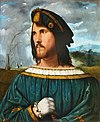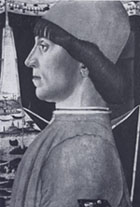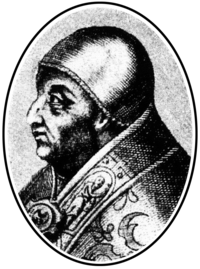
Cesare Borgia was an Italian cardinal and condottiero, an illegitimate son of Pope Alexander VI and member of the Valencian (Spanish-Aragonese) House of Borgia. His fight for power was a major inspiration for The Prince by Niccolò Machiavelli.

Pope Alexander VI (epithet: Valentinus was head of the Catholic Church and ruler of the Papal States from 11 August 1492 until his death in 1503. Born into the prominent Borgia family in Xàtiva in the Kingdom of Valencia under the Crown of Aragon, Rodrigo studied law at the University of Bologna. He was ordained deacon and made a cardinal in 1456 after the election of his uncle as Pope Callixtus III, and a year later he became vice-chancellor of the Catholic Church. He proceeded to serve in the Curia under the next four popes, acquiring significant influence and wealth in the process. In 1492, Rodrigo was elected pope, taking the name Alexander VI.
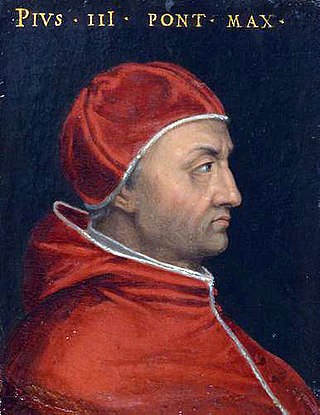
Pope Pius III, born Francesco Todeschini, was head of the Catholic Church and ruler of the Papal States from 22 September 1503 to his death. At just twenty-six days, he had one of the shortest pontificates in papal history.

Pope Julius II was head of the Catholic Church and ruler of the Papal States from 1503 to his death, in February 1513. Nicknamed the Warrior Pope, Battle Pope or the Fearsome Pope, he chose his papal name not in honour of Pope Julius I but in emulation of Julius Caesar. One of the most powerful and influential popes, Julius II was a central figure of the High Renaissance and left a significant cultural and political legacy. As a result of his policies during the Italian Wars, the Papal States increased their power and centralization, and the office of the papacy continued to be crucial, diplomatically and politically, during the entirety of the 16th century in Italy and Europe.

The House of Borgia was a Spanish noble family, which rose to prominence during the Italian Renaissance. They were from Xàtiva, Kingdom of Valencia, the surname being a toponymic from the town of Borja, then in the Crown of Aragon, in Spain.

Ascanio Maria Sforza Visconti was an Italian Cardinal of the Catholic Church. Generally known as a skilled diplomat who played a major role in the election of Rodrigo Borgia as Pope Alexander VI, Sforza served as Vice-Chancellor of the Holy Roman Church from 1492 until 1505.

The Renaissance Papacy was a period of papal history between the Western Schism and the Reformation. From the election of Pope Martin V of the Council of Constance in 1417 to the Reformation in the 16th century, Western Christianity was largely free from schism as well as significant disputed papal claimants. There were many important divisions over the direction of the religion, but these were resolved through the then-settled procedures of the papal conclave.

Ippolito (I) d'Este was an Italian Roman Catholic cardinal, and Archbishop of Esztergom. He was a member of the ducal House of Este of Ferrara, and was usually referred to as the Cardinal of Ferrara. Though a bishop of five separate dioceses, he was never consecrated a bishop. He spent much of his time supporting the ducal house of Ferrara and negotiating on their behalf with the Pope.

The 1492 papal conclave was convened after the death of Pope Innocent VIII. It was the first papal conclave to be held in the Sistine Chapel.

Giovanni Antonio Sangiorgio was an Italian canon lawyer and Cardinal. Agostino Oldoino calls him the leading jurisconsult of his age. Kenneth Pennington has called him one of the ‘last two great commentators on feudal law’.

The 1458 papal conclave, convened after the death of Pope Callixtus III, elected as his successor Cardinal Enea Silvio Piccolomini who took the name Pius II.
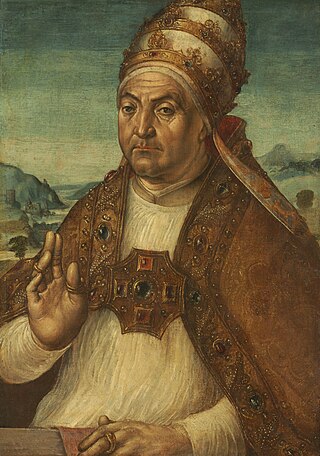
The 1471 papal conclave elected Pope Sixtus IV following the death of Pope Paul II. With the exception of the conclaves of the Western Schism, this conclave was the first since 1305 to feature a working, two-thirds majority of Italians within the College of Cardinals, in no small part because of the absence of six non-Italian cardinals. This was in part due to the unexpectedness of the death of Paul II.

The October 1503 papal conclave elected Cardinal Giuliano della Rovere as Pope Julius II to succeed Pope Pius III. The conclave took place during the Italian Wars barely a month after the papal conclave, September 1503, and none of the electors had travelled far enough from Rome to miss the conclave. The number of participating cardinals was thirty-eight, the College of Cardinals having been reduced by the election of Piccolomini as Pius III, who did not elevate cardinals. At a consistory on 11 October Pope Pius had proposed to make Cardinal d'Amboise's nephew a cardinal, as part of his effort to conciliate the French, but the response from the cardinals was not enthusiastic.

The Conclave is a 2006 Canadian/German film production directed by Christoph Schrewe. The script was written by Paul Donovan.

Giuliano Cesarini the Younger was an Italian Catholic prelate and cardinal.

Juan de Vera, known as the Cardinal of Salerno, was a Spanish Roman Catholic bishop and cardinal.

Juan Castellar y de Borja (1441–1505) was a Spanish Roman Catholic bishop and cardinal.

Francisco de Remolins (1462–1518) was a Spanish Roman Catholic bishop and cardinal.
Two papal conclaves were held in 1503.

Niccolò Bonafede was a Roman Catholic prelate who served as Bishop of Chiusi (1504–1533).



